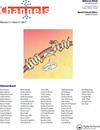293T细胞中TREK-1c电流升高中细胞内运输的参与
IF 3.2
3区 生物学
Q2 BIOCHEMISTRY & MOLECULAR BIOLOGY
引用次数: 3
摘要
TREK-1通道,即twik -1相关的钾离子(K+)通道,是2孔域钾离子(K2P)通道家族的一员,背景或泄漏K+电流通过该通道发生。TREK-1通道的一个有趣特征是电流的上升:即在整个细胞结构形成的几分钟内,通过TREK-1通道的电流会自发地增加。为了研究细胞内转运是否参与了助跑过程,我们建立了293T细胞系,稳定表达TREK-1c通道(K2P2.1),并检测了膜蛋白转运抑制剂n-甲基丙烯酰亚胺(NEM)、brefeltin - a和内噬抑制剂pitstop2对助跑过程的影响。结果显示NEM和brefeltin - a抑制和pitstop2促进了助跑,这表明NEM和brefeltin - a参与了细胞内蛋白运输。相应地,在稳定表达mCherry-TREK-1融合蛋白的细胞中,NEM降低,pitstop2增加融合蛋白的细胞表面定位。此外,细胞内应用与微管相关蛋白2 (Mtap2)相互作用位点对应的c端片段TREK335-360的肽可以抑制这种上升。该肽还抑制Mtap2与抗mcherry抗体的共免疫沉淀。ezrin抑制剂(NSC668394)的细胞外应用也抑制了融合蛋白的上升和表面定位。这些抑制剂的共同应用消除了TREK-1c电流,表明ezrin和Mtap2的加性作用增强了TREK-1c通道的表面表达和上升。这些发现清楚地表明细胞内转运参与TREK-1c电流升高及其机制。本文章由计算机程序翻译,如有差异,请以英文原文为准。
Involvement of intracellular transport in TREK-1c current run-up in 293T cells
ABSTRACT The TREK-1 channel, the TWIK-1-related potassium (K+) channel, is a member of a family of 2-pore-domain K+ (K2P) channels, through which background or leak K+ currents occur. An interesting feature of the TREK-1 channel is the run-up of current: i.e. the current through TREK-1 channels spontaneously increases within several minutes of the formation of the whole-cell configuration. To investigate whether intracellular transport is involved in the run-up, we established 293T cell lines stably expressing the TREK-1c channel (K2P2.1) and examined the effects of inhibitors of membrane protein transport, N-methylmaleimide (NEM), brefeldin-A, and an endocytosis inhibitor, pitstop2, on the run-up. The results showing that NEM and brefeldin-A inhibited and pitstop2 facilitated the run-up suggest the involvement of intracellular protein transport. Correspondingly, in cells stably expressing the mCherry-TREK-1 fusion protein, NEM decreased and pitstop2 increased the cell surface localization of the fusion protein. Furthermore, the run-up was inhibited by the intracellular application of a peptide of the C-terminal fragment TREK335–360, corresponding to the interaction site with microtubule-associated protein 2 (Mtap2). This peptide also inhibited the co-immunoprecipitation of Mtap2 with anti-mCherry antibody. The extracellular application of an ezrin inhibitor (NSC668394) also suppressed the run-up and surface localization of the fusion protein. The co-application of these inhibitors abolished the TREK-1c current, suggesting that the additive effects of ezrin and Mtap2 enhance the surface expression of TREK-1c channels and the run-up. These findings clearly showed the involvement of intracellular transport in TREK-1c current run-up and its mechanism.
求助全文
通过发布文献求助,成功后即可免费获取论文全文。
去求助
来源期刊

Channels
生物-生化与分子生物学
CiteScore
5.90
自引率
0.00%
发文量
21
审稿时长
6-12 weeks
期刊介绍:
Channels is an open access journal for all aspects of ion channel research. The journal publishes high quality papers that shed new light on ion channel and ion transporter/exchanger function, structure, biophysics, pharmacology, and regulation in health and disease.
Channels welcomes interdisciplinary approaches that address ion channel physiology in areas such as neuroscience, cardiovascular sciences, cancer research, endocrinology, and gastroenterology. Our aim is to foster communication among the ion channel and transporter communities and facilitate the advancement of the field.
 求助内容:
求助内容: 应助结果提醒方式:
应助结果提醒方式:


